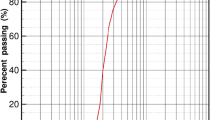Abstract
A new concept for constructing the facing of soil-nailed walls is proposed and validated through experimental and numerical approaches. This new process uses precast concrete panels. For each excavation step, the soil reinforcements are first connected to the panels. A slightly cemented 4–6-mm crushed stone is then injected, through the weep holes, between the panels and the excavation vertical cut, applying a confining pressure to the ground and providing continuous high-capacity drainage behind the facing. The structural design of the precast reinforced concrete panel, based on full-scale loading tests in the laboratory and nonlinear numerical simulations, is presented in detail. Crack initiation and failure modes are properly predicted by the model. A full-scale experimental soil-nailed wall 7.5 m high was also built to evaluate the environmental, economic and mechanical performances of the new construction technique compared to the conventional shotcrete technique. The new construction technique greatly improves worker’s safety, significantly reduces construction duration and cost and improves the mechanical behaviour of the soil-nailing technique and drainage of the facing. Compared to the conventional shotcrete technique, the new technique reduces concrete consumption by 64% and greenhouse gases emission by 56%.















Similar content being viewed by others
References
Chavan D, Mondal G, Prashant A (2017) Seismic analysis of nail soil slope considering interface effects. Soil Dyn Earthq Eng 2017(100):480–491. https://doi.org/10.1016/j.soildyn.2017.06.024
Colin JG, Chouery-Curtis VE, Berg RR (1992) Field observations of reinforced soil structures under seismic loading. In: Proceedings of the international symposium on earth reinforcement, Fukuoka, Japan, vol 1, pp 223–8.
Tatsuoka F, Tateyama M, Koseki J, Uchimura T (1995) Geotextile-reinforced soil retaining wall and their seismic bahaviour. In: Proceedings of 10th Asian regional conference on soil mechanics and foundation engineering, vol 2, pp 26–49.
Juran I (1987) Nailed-soil retaining structures: design and practice. Transp Res Rec 12:139–150
Bruce DA, Jewell RA (1986) Soil nailing: application and practice-part 1. Ground Eng 19(8):10–15
Schlosser F, Unterreiner P, Plumelle C (1993) Validation of calculation methods of soil nailed walls based on the experimentations of the National Project CLOUTERRE. Rev Fr Geotech 3:11–20. https://doi.org/10.1051/geotech/1993064011
Menkiti CO, Long M (2008) Performance of soil nails in Dublin glacial till. Can Geotech J 45:1685–1698. https://doi.org/10.1139/T08-084
TT Bui A Limam 2015 Paroi Clouée Préfabriquée: evaluation de la capacité portante d’une écaille constitutive: approche expérimentale et numérique. Internal report, France
Lubliner J, Oliver J, Oller S, Oñate E (1989) A plastic-damage model for concrete. Int J Solids Struct 25:299–326
Lee J, Fenves G (1998) Plastic-damage model for cyclic loading of concrete structures. J Eng Mech 124:892–900
Nana WSA, Bui TT, Limam A, Abouri S (2017) Experimental and numerical modelling of shear behaviour of full-scale RC slabs under concentrated loads. Structures 10:96–116. https://doi.org/10.1016/j.istruc.2017.02.004
Bui TT, Limam A, NaNa WSA, Roure T, Arrieta B (2018) Cast-in-place headed anchor groups under shear: experimental and numerical modelling. Structures 14:178–196
ADEME (2014) Documentation des facteurs d'émissions de la Base Carbone ®, Version 11.0.0, Nov 2014.
Jean de Sauvage (2018) Etude du comportement des murs de soutènement par clouage des sols en place : application au dimensionnement du parement. PhD doctoral dissertation. IFSTTAR, Bron, 30 Nov /2018.
Acknowledgements
This research project was funded by NGE FONDATION, Saint-Priest, France.
Author information
Authors and Affiliations
Corresponding author
Rights and permissions
About this article
Cite this article
Bui, T.T., Bost, M., Limam, A. et al. Modular precast concrete facing for soil-nailed retaining walls: laboratory study and in situ validation. Innov. Infrastruct. Solut. 5, 1 (2020). https://doi.org/10.1007/s41062-019-0250-z
Received:
Accepted:
Published:
DOI: https://doi.org/10.1007/s41062-019-0250-z




